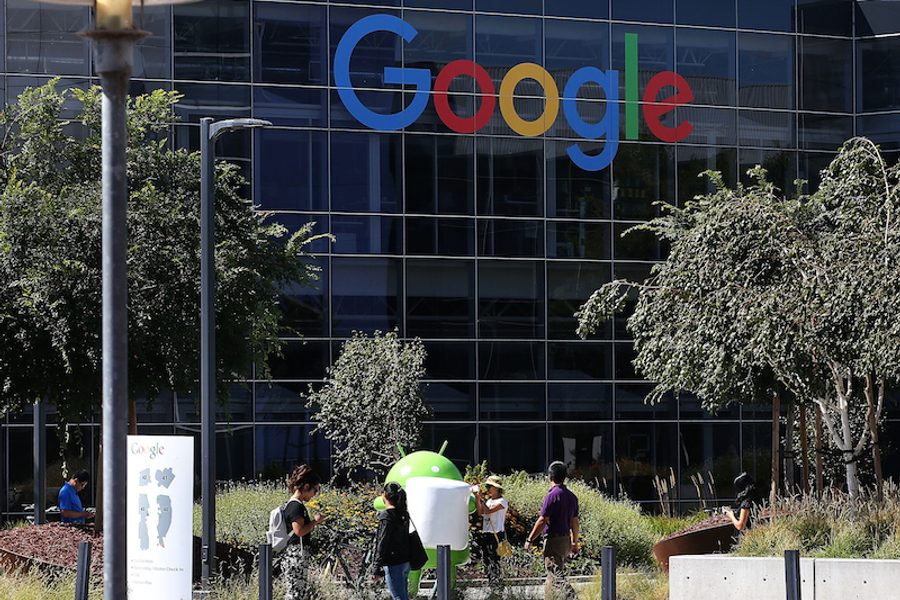Silicon Valley’s Labor Uprising
Unions are spreading like wildfire through tech’s low-wage workforce
s.e. smith

Gabriel Cárdenas, 27, works in the warehouses of Google Express — Google’s same-day and overnight online shopping and delivery service — loading and unloading trucks. The sometimes suffocatingly hot warehouse in Palo Alto, Calif., is a far cry from the beautifully appointed Google campus in nearby Mountain View, with its radiant cooling system.
But Cárdenas doesn’t work for Google. He works for Adecco, a staffing company that provides contract labor to Google and other tech firms. He’s part of the teeming support workforce of janitors, bus drivers, food service workers, security guards and other low-paid workers who keep Silicon Valley running. Though they report to work every day alongside coders, developers and other mid-level staff, they are cut out of the famously high salaries and benefits of the tech elite. The wage differential is about much more than a difference in skill sets or qualifications. Relying on outside staffing firms saves tech companies money, as they don’t need to give sub-contracted workers access to the same benefits (such as health care and paid leave) that direct employees receive. Staffing agencies offer low bids and make workers pay the price in limited — or nonexistent — benefits.
Employees of staffing companies are starting to revolt, however, ushering in what may be a new era of higher labor standards in the famous tech hub. These workers are organizing, voting for union membership and the power of collective bargaining, and publicly exposing their working conditions — namechecking the companies that contract their services — in the hopes of stirring up popular support. “Adecco” may not mean anything to the average consumer, but “Google” certainly does — and many Google customers care about corporate accountability. If workers succeed, they could have a huge influence on newer tech hubs like New York and Chicago.
Valley of plenty, for a few
Silicon Valley stretches across 1,854 square miles of former fruit trees and includes some of the most highly valued land — and companies — in the United States. Apple is worth $1 trillion; Google $383 billion; Facebook $250 billion. Tech professionals at such companies make a mean annual wage of $112,610, according to a 2014 survey by technology-career website Dice.com.
Support workers say they want the slice they’ve earned of this highly profitable pie. Cárdenas got the idea to organize his coworkers during a fall 2014 sociology course at Evergreen Valley College in San Jose, where he is earning his associate degree. Describing labor confrontations with employers, instructor Frank Espinoza told Cárdenas, “When you go up against a Goliath like that, you’ve got to have a lot of Davids.” The message that workers have tremendous power in numbers had a profound influence on Cárdenas. He began talking to fellow Adecco employees at Google Express about whether they needed a union. There were numerous labor issues at the warehouse: a two-year limit on employment; dangerous working conditions, like cracked floors and damaged electrical systems; the stifling heat; low hourly wages of $13 to $14.
Adecco responded to the rumblings in the workforce with a combination of pacification — ventilation was improved, Cárdenas says — and union-busting. Teamsters Vice President Rome Aloise tells In These Times that the company brought in Jackson Lewis, the notorious anti-union law firm, and used “every trick in the book to scare and intimidate the workers.” Cárdenas and Aloise say lawyers walked the floor and managers pulled workers aside or held lengthy “captive audience” meetings to preach the pitfalls of unionization. Ironically, Adecco also suspended Cárdenas for a day and a half on charges that he was bullying coworkers in the course of his labor organizing, which he denies. (Aloise tells In These Times that the Teamsters will be filing an NLRB complaint on behalf of Cárdenas, along with two employees who believe their firings were retaliatory.)
Asked for comment on workers’ claims of labor problems and union-busting, an Adecco spokesperson said, “There have been a number of false claims made throughout this election process; we’re not able to comment on active legal matters but objections were filed with the NLRB around the election process. … We will fully cooperate with the NLRB’s investigation and the upcoming hearing.” She added that the company is “supportive of any direction freely chosen by our associates” but “believe[s] that our associates are better off directly dealing with us as their employer rather than involving a union.”
Apparently, workers didn’t share that belief. Adecco employees voted on August 21 to join the Teamsters, yet another milestone in what might be considered tech’s comeuppance — the moment when labor organizing spread like wildfire across Silicon Valley.
The first major stirrings began in May 2014, when venerable civil rights organizer Jesse Jackson launched a campaign focusing on racial and class disparities in the Valley with a bang, rallying for better working conditions for security guards at the offices of semiconductor manufacturer Broadcom. In September 2014, security guards mobbed an Apple store to chant, “Apple, Apple, you’re no good, treat your workers like you should.” Unite Here protesters gathered at Intel’s Santa Clara offices in November 2014 to hold the firm accountable for unfair treatment of food service workers employed by a catering company. In a December 2014 protest, Jackson led a crowd of security guards and food service workers — the majority of whom, like other contract workers, were people of color — in a rally at Apple’s Bay Area campus in an “Apple dodges taxes, we pay the price” chant.
The Teamsters have seen four union victories in 2015: the warehouse workers at Google Express, waste disposal workers at Genentech, and workers at two transportation companies that collectively serve Apple, Genentech, Yahoo, eBay, Zynga, Evernote and Amtrak. These are the drivers of the infamous symbols of Silicon Valley’s burgeoning class war: the elite private buses from San Francisco and environs to Silicon Valley. (In recent years, the buses, which are exclusive to tech employees, have attracted considerable contro- versy over their use of city bus stops.) According to Aloise, the new contracts cover more than 200 drivers and guarantee wages of roughly $60,000 and affordable health insurance.
In addition to the Teamsters and Unite Here, the Service Employees International Union (SEIU) has begun organizing workers with the help of the South Bay AFL-CIO Labor Council. SEIU campaigns are underway at two of the largest Silicon Valley security staffing companies, Universal Protection Service and Security Industry Specialists.
Norman Meeks is a Universal Protection Service guard who is working with SEIU to organize his coworkers. Guards, he says, make $10 to $12 an hour with no benefits, except an option to buy into an expensive health insurance plan. Like the other workers keeping Silicon Valley afloat, they earn these near-minimum wages while working in the third-most expensive location in the country.
A tale of two valleys
Housing costs are shooting up in the Bay Area; San Jose’s rents, for example, rose 12 percent in 2014 alone. Even far-flung and once-affordable regions of the Bay Area, like Richmond and Walnut Creek, are growing too expensive for many working-class people. Plan Bay Area, a regional development plan, found that Silicon Valley janitors earn an average of $25,000 a year and spend more than half on housing and transit. Unionizing and negotiating for better pay, Aloise says, may enable some workers to afford to live in Silicon Valley and build lives in the communities where they work.
Silicon Valley’s income gap also falls along stark racial lines, which is one reason Jesse Jackson has become involved in labor organizing there. Derecka Mehrens of community-labor coalition Working Partnerships USA describes the situation as one of “occupational segregation.” Black and Latino workers are heavily underrepresented among programmers and other top-paid tech personnel, and they’re heavily overrepresented on the flip side of the coin: that is, the people who drive these staffers to work, clean up after them, feed them in lavish corporate cafeterias, and keep them safe. White and Asian workers account for 21 percent of janitorial staff in Silicon Valley, but 91 percent of personnel at Google, according to statistics the company released in 2014 — a good barometer for the industry as a whole, as many tech firms are reluctant to disclose diversity data.
The tech industry defends itself by arguing that it needs to attract skilled coders. With an abundance of jobs to choose from, programmers are enticed by companies with the best packages, including famous perks like Google’s in-house massage therapists.
But notably, the programming labor force is starting to grow, thanks to numerous tech training programs and the foreign workers brought in on H-1B visas (who are often under-paid and housed in cramped company quarters while they churn out code). Already, software engineers write the bulk of new code, while a large pool of programmers act more like assembly line workers, snapping together lines of pre-existing code. Wages in some sectors of software development are starting to fall as a result of a flooded labor market and a trend of hiring fresh, younger workers who cost less than their experienced counterparts. The infamous brogrammers of Silicon Valley, in other words, may want to consider whether they should be look- ing into union petitions of their own.
Real employees, please stand up
Seeing the writing on the wall, some high-profile tech companies are tak- ing steps to improve standards for the workers they hire through staffing agencies. In May, perhaps feeling the heat from the Fight for 15 movement, Facebook announced that it would be mandating a $15 minimum wage and various benefits at contractors and vendors that perform “a substantial amount of work” for Facebook. Other companies are bringing formerly sub-contracted employees in-house, as Google did in October 2014 with its security services and Apple did in March 2015 with its security guards.
But relying on tech firms to voluntarily promote better working conditions is unwise, says Derecka Mehrens of Working Partnerships USA. Once support workers are moved in-house, tech companies aren’t obliged to meet the terms of the union contracts negotiated with staffing firms, and it’s vanishingly rare for tech firms themselves to be unionized.
Labor lawyer Moshe Marvit also notes that voluntary initiatives like Facebook’s don’t include an oversight mechanism. Indeed, Facebook has yet to give details on whether it has implemented its plan. Unions provide more surety; workers have a contract and a system for reporting violations and filing grievances.
An NLRB ruling in late August may introduce such oversight mechanisms, whether tech firms like it or not. In Browning-Ferris, the NLRB clarified its standard for whether two companies constitute “joint employers.” Previously, staffing firms and their clients were only considered joint employers if clients exercised a degree of control over workers, such as requiring background checks or setting hours. Now, the NLRB says, if a client could theoretically exercise control — even if it doesn’t — it’s considered a joint employer.
Marvit believes this ruling could have a huge impact on Silicon Valley. Now, companies cannot look the other way on wages and working conditions, and when subcontracted workers unionize, staffing agencies and the firms that use them both have to come to the bargaining table.
As union campaigns proliferate, the warehouses, breakrooms and cleaning closets of Silicon Valley could be the breeding grounds for something larger. Silicon Valley is the standard-setter in one of the few booming sectors of the economy. The region is a test case for how profits are shared in the 21st century. Will a hugely lucrative industry distribute the wealth to the many who make its success possible, from star visionaries to janitors, or will it continue to concentrate its profits in the hands of the few?








